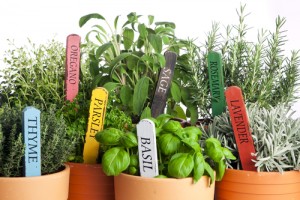
Save money by starting your own herb garden this year! Via Shutterstock.
I LOVE fresh herbs. Adding some fresh basil, cilantro, or parsley can make a dish so much more delicious. While I adore cooking with fresh herbs, I hate having to go the store and constantly buy them. Especially since they tend to wilt so quickly! That’s why this year I decided to make my own herb garden at home. Interested in starting your own herb garden but not sure where to start? Let us help!
How to Start an Herb Garden
4 Reasons Why You Should Start an Herb Garden
1. Save Money! – Of course the #1 reason to start an herb garden is because it saves you money! Fresh herbs can be expensive especially when you purchase them individually every time you need them. You end up wasting most of your purchase (I NEVER use that whole bunch of cilantro or basil..do you!?) and wasting money is never a good thing! After the initial cost of starting your herb garden you’ll have free fresh herbs whenever you like.
2. Health Benefits – Eating fresh herbs is an easy and delicious way to add vitamins to your diet. The time you’ll spend tending your garden will also be beneficial to your health. The physical acts of digging, bending, and stretching that come with gardening will help you stay in shape!
3.Fresh Herbs All the Time – With an herb garden you can have fresh herbs whenever you like. You’d be surprised how much a handful of fresh basil can change a sandwich or salad. Yum! There’s nothing better than walking to your window or outside garden and just grabbing what you need. No grocery store necessary!
4. Low Maintenance – An herb garden is the most low maintenance garden you can have. Herbs are very hardy which means you don’t have to worry much about them. This is one of the many reasons that makes them great for beginning gardeners. All you really have to do is check them for insects and water regularly and you’ll have delicious herbs all year. Wow!
What You Need
1. Herbs – You will want to buy a plant instead of starting from seeds. Little starter plans are usually available at grocery stores and home improvement stores such as Lowe’s or Home Depot for close to the same price as a pack of seeds.Farmer’s markets are also a great place to find fresh herb plants. These are much easier to grow as most of the work has already been done for you!
2. Pot or Planters – Containers can be the most expensive part of growing your herb garden but they don’t have to be. You can make your planters from mason jars, tea containers, or even newspaper! Check out these 10 low budget ideas for herb container ideas here.
3. Extra Soil for Replanting/ Plant Food – A small bag of soil is all that you’ll need. I personally swear by Miracle Grow and you can usually find a bag for $10 or less that will last you a good while.
4. Tools – When starting an herb garden you’ll want to have a few tools on hand such as:
- A trowel/or small shovel
- A water can/or pitcher
- Herb Scissors
5. Sunlight – When starting an herb garden sunlight is an essential component. Make sure you have a southwestern-facing window or artificial light if natural light is not available.
What Herbs to Grow
Basil – The first herb I ever grew was basil! It’s one of the easiest plants to grow because it lets you know when it needs water because it looks wilted but goes back to normal after a nice watering. It also is a great herb to have around because it can be added to a wide variety of dishes!
Mint – Mint is an herb that grows quickly and become invasive unless it’s confined in a pot. Since it grows in full sun or partial shade it’s perfect for growing inside. There’s nothing better than fresh mint mojitos and I love to add mint to lemonade or iced tea. Yum!
Parsley – This herb needs a lot of sun so you’ll want to make sure to place it in a sunny area but it is otherwise very easy to grow. I love to use parsley in sauces, marinade, and salads.
Cilantro – Cilantro can tolerate a little shade but it grows best in the sun so look for a sunny area for this herb as well! You’ll also want to plan it in a container that’s at least 8-12 inches deep because it has a long taproot. Cilantro tastes amazing when mixed with avocado for guacamole and I love to use it in salsa too!
AND TONS MORE! – Don’t see your favorite herb here? Don’t worry there are TONS of other options that can also be grown at home. Check out this list of 56 herbs from Better Homes and Gardens.
Note: If you are a beginning gardener, I recommend starting with 2-3 herbs and adding more as you become comfortable.


Reflecting on my experience at Mona Vale Dental, I must commend their impeccable service and transparent approach regarding dental implants cost. From the initial consultation to the final procedure, their team demonstrated expertise and professionalism. I felt confident and well-informed every step of the way. Without a doubt, Mona Vale Dental sets the standard for excellence in dental care.